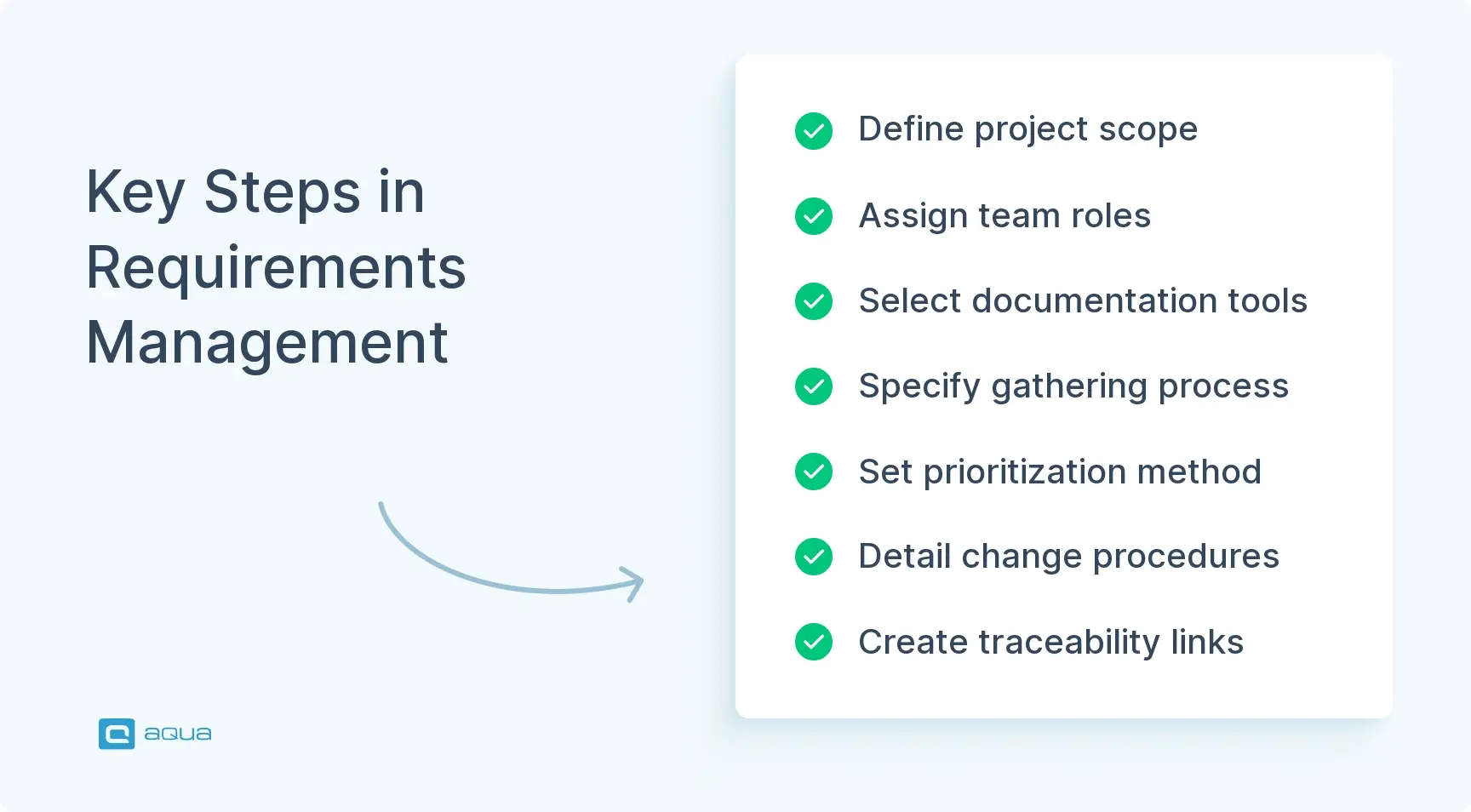Key Takeaways
- A Requirements Management Plan outlines how project requirements will be defined, documented, analyzed, traced, prioritized, and controlled throughout the project lifecycle.
- Projects with well-defined requirements are 2-3 times more likely to succeed than those with poorly managed requirements.
- Key components include project overview, roles and responsibilities, tools selection, gathering processes, prioritization frameworks, change procedures, and traceability matrices.
- The implementation phase involves configuring selected tools, training team members on the methodology, and executing requirements gathering with stakeholders.
- Regular requirements reviews ensure they remain relevant as business conditions change, preventing static documentation that loses value over time.
Up to 40% of software development project failures stem from poor requirements management. Learn how to create a plan that prevents scope creep, aligns your team, and dramatically improves your project outcomes 👇
What is a Requirements Management Plan?
A requirements management plan is a formal document that defines how you’ll handle project requirements from start to finish. It covers how you’ll collect them, document them, prioritize them, and manage changes along the way.
Think of it as your instruction manual for requirements. While a requirements document lists what needs to be built, the management plan explains the system for keeping those requirements organized and under control. It tells everyone how requirements flow from initial stakeholder conversations through implementation and final verification.
Here’s what that looks like in practice. A software team might use user stories to capture functionality requests, track everything in Jira, and require product owner approval for any scope changes. The plan spells out these processes so nobody has to guess how things work when questions come up.
The best requirements management plans become working documents that teams actually reference. When someone asks about scope or how to handle a new request that wasn’t in the original vision, the plan has the answer. It lives in your workflow, not buried in some folder nobody opens.
Key Components of a Requirements Management Plan
A requirements management plan needs several core elements to actually work. Each piece plays a specific role in keeping requirements organized and manageable throughout your project.
Project Overview
Start with context. Explain what the project does, why it matters, and how it fits into your organization’s bigger goals. Keep it short but clear enough that anyone reading the plan understands the purpose.
Something like: “We’re building a mobile fitness app that connects to our existing web platform. This expands our reach to mobile users and helps us compete in the growing fitness tracking market.” That’s enough context without overexplaining.
Roles and Responsibilities
Without clear ownership, requirements management falls apart fast. Define who does what so nobody assumes someone else is handling critical tasks.
Your plan should cover these key roles:
- Project Sponsor authorizes resources and approves final priorities
- Business Analyst collects requirements from stakeholders and documents them
- Product Owner prioritizes requirements and makes tradeoff decisions
- Development Team builds features and flags technical feasibility issues
- QA Team verifies that what got built actually matches the requirements
- Stakeholders provide input and validate that requirements are accurate
Spell out what each role handles for gathering, approving, implementing, and verifying requirements. This prevents confusion when decisions need to happen.
Tools and Templates
Pick your tools and stick with them. Standardizing creates consistency and makes communication smoother across the team.
Common requirements management software options include aqua cloud for the whole requirements management process including documentation and test management, Jira for tracking implementation, and Confluence for detailed specs. Your plan should specify which tools you’re using and how they’re configured for your project.
Include sample templates so everyone knows the expected format and level of detail. Many teams use a requirements management plan template to keep things consistent across different projects.
Requirements Gathering Process
This explains how you’ll collect stakeholder needs and turn them into actual requirements. Your process determines the quality of your requirements, so get this right.
Document which techniques you’ll use (interviews, workshops, surveys, observation), which stakeholders provide input for different requirement types, and how you’ll resolve conflicts when stakeholders disagree. Specify the format for capturing raw input before it becomes formal requirements.
For example: “We’ll gather UX requirements through stakeholder interviews and watching users interact with the current system. Sessions get recorded and transcribed, then the BA team analyzes them to identify patterns and needs.”
As you work on defining your requirements management plan, the challenge often lies in creating a system that maintains both structure and flexibility while ensuring complete traceability. This is exactly where aqua cloud shines as a comprehensive solution for modern requirements management. With aqua, you can organize requirements in customizable hierarchies, establish direct links between requirements and test cases, and visualize coverage gaps instantly through interactive dashboards. The platform’s robust traceability features generate visual dependency graphs that instantly reveal the connections and potential impacts of any changes – a critical capability mentioned in our discussion of traceability matrices above. What truly sets aqua apart is its domain-trained AI Copilot that can generate requirements documentation from various inputs and automatically create relevant test cases with proper linking, saving up to 97% of documentation time while maintaining the context-awareness that generic AI tools lack.
Achieve 100% requirements traceability with AI-powered documentation in minutes, not days
Prioritization Framework
You need a clear system for ranking requirements. Without one, teams waste time on the wrong features or get paralyzed by competing demands.
Define your prioritization model (RICE, MoSCoW, value versus effort, or another approach), the criteria for evaluating importance, and who makes the final call on priorities. Specify how often you’ll revisit priorities and how conflicts get resolved.
Using MoSCoW as an example, you might say “Must have” means regulatory compliance or core user journeys, while “Should have” improves efficiency but isn’t critical. Document this so everyone uses the same logic when making decisions.
Change Management Procedures
Changes happen. The question is whether you control them or they control you.
Specify how people submit change requests, what the review process looks like, and who approves what based on the size of the change. Detail what documentation updates are required and how you’ll notify stakeholders.
For instance: “Minor changes that don’t affect scope, timeline, or budget go through the product owner. Moderate changes need the weekly change control board. Major changes affecting project constraints require executive sponsor approval.”
Following best practices for requirements changes management prevents scope creep while keeping the project flexible enough to adapt when needed.
Traceability Matrix
A traceability matrix tracks how requirements connect to everything else in your project. It ensures you can follow each requirement from origin through design, implementation, and testing.
Explain what relationships you’ll track, how the matrix is structured, who maintains it, and which tool manages it. Comprehensive traceability might connect business objectives to requirements, requirements to design elements, requirements to test cases, and requirements to final deliverables.
This tracking catches things before they slip through the cracks and makes it easier to assess how changes ripple through your project.
Validation and Verification Methods
Validation confirms you understood the requirements correctly. Verification confirms you built them correctly. Both matter if you want the final product to actually meet stakeholder needs.
Document how requirements get reviewed for quality before acceptance, how you’ll validate they reflect what stakeholders want, and how you’ll verify implementation. Specify testing approaches for different requirement types and who participates in validation and verification.
Your plan might require peer review before baseline approval, stakeholder validation through prototype demos, and verification through automated testing where possible. These defined methods catch misunderstandings before they become expensive fixes.
Creating Your Requirements Management Plan: Step by Step
Building a requirements management plan is easier when you break it into clear steps. Here’s how to actually create one that your team will use.
Define Project Scope
Start by figuring out what’s in and what’s out. Meet with key stakeholders to nail down the project purpose, objectives, and constraints. Document the business problem you’re solving and the specific deliverables people expect.
Be explicit about exclusions. If you’re building an inventory management system, maybe it includes tracking physical inventory and generating reports but excludes accounting functions or certain legacy integrations. Writing this down prevents “wait, I thought we were doing that too” conversations later.
A clear scope becomes your filter for evaluating requirements. When someone suggests a new feature, you can check it against the scope to see if it’s legitimate or scope creep. This makes managing stakeholder expectations much easier.
Develop Methodology
Now decide how you’ll actually manage requirements. Your methodology needs to match your organization’s culture, project complexity, and team experience.
Ask yourself: Are you doing traditional waterfall with comprehensive upfront requirements, or an agile requirements management plan where requirements evolve? How formal does the process need to be? (Regulated industries need more rigor than a simple internal tool.) What level of detail makes sense for your documentation? How do you handle requirements across multiple teams?
An agile approach might use user stories in a product backlog with continuous refinement during sprint planning. A traditional approach might need formal requirements specifications with structured review cycles. Pick what fits your situation and document why you made that choice. This helps get stakeholder buy in and keeps everyone applying the methodology consistently.
The quality management plan sets the standards, guidelines and procedures that will ensure that products/ process will be within range of acceptable parameters. The purpose of requirements management plan is to ensure that the project objectives are achieved.
Implementation
This is where the plan becomes real. Set up your tools, train your team, and establish the workflows that support your requirements process.
Configure your requirements management environment first. Set up templates, fields, and workflows in your chosen tools. Create repositories for documentation. Establish traceability relationships in the system. Build dashboards that show requirements status at a glance.
Then, onboard your team. Run training sessions on the tools and templates. Walk through the methodology and explain why you’re doing it this way. Clarify who handles what for different requirements activities. Practice the workflows with simple examples so everyone gets comfortable.
Start executing the process according to your plan. Kick off requirements gathering with stakeholders. Document initial requirements using your templates. Apply your traceability approach from day one. Schedule regular checkpoints to verify things are working.
Stay flexible during implementation. The best plans evolve based on what actually works for your team. Get feedback early and adjust as needed.

Best Prompts for Requirements Management Planning
AI and LLM tools can accelerate requirements management tasks by reducing manual work. For example, they can transform stakeholder notes into structured requirements, identify gaps in your traceability matrix, and much more. All you need is the right input, an LLM model, and tailored prompts. The two prompt examples below show how you can use AI to complete different requirements management tasks in just a few minutes.
Prompt 1: Convert Stakeholder Interview Notes to Structured Requirements
Copy and paste the following prompt into an LLM model of your choosing:
Outcome: AI provides a complete requirements specification in markdown format. When you paste it into Google Docs, the table auto-formats with borders and columns. You get ready-to-use requirements plus a follow-up question list for your next stakeholder meeting. Simply copy-paste, then make minor adjustments for project-specific terminology.
Expected Benefit: Saves significant initial documentation time and helps identify ambiguous statements that need clarification.
Prompt 2: Generate a Traceability Impact Analysis
Copy and paste the following prompt into an LLM model of your choosing:
Outcome: AI delivers a change impact report that pastes directly into Google Docs with proper formatting. You receive a decision-ready document showing exactly what breaks, what needs updating, and who needs to approve. The checkbox format makes it actionable immediately, just assign tasks to team members.
Expected Benefit: Prevents scope creep and unexpected rework. Identifies hidden dependencies and ripple effects that might take hours to map manually, reducing post-change defects.
These prompts can help you with specific requirements documentation or analysis tasks. But what if you could do most of your manual labor-heavy QA tasks in a few clicks, directly inside your requirements management workflow? That’s exactly what aqua, an AI-powered test and requirement management platform that brings these prompt-based benefits to life without switching context. The domain-trained AI Copilot generates requirements from voice notes, text, or even rough drafts in seconds. It understands your project context, unlike generic AI tools. You get instant traceability from requirements to test cases with visual dependency graphs. No more manual linking or spreadsheet chaos. aqua integrates seamlessly with Jira, Azure DevOps, and Confluence, so your requirements flow automatically between systems. Your team stays synchronized without friction. The AI handles the heavy lifting while you focus on validation and stakeholder alignment. Turn hours of requirements work into minutes.
Cut requirements documentation time by 97%
Best Practices for Effective Requirements Management
Having a plan is one thing. Following practices that actually make requirements management work is another. These proven approaches help teams avoid common problems and get real value from their requirements work.
- Start with stakeholder analysis. Map out who needs to provide input, who approves decisions, and who needs updates. This prevents missing critical perspectives or getting blindsided by someone you didn’t know had veto power.
- Review requirements regularly. Requirements shouldn’t sit untouched in a folder somewhere. Schedule reviews with business stakeholders to confirm continued value and with technical teams to surface implementation challenges before they become blockers.
- Train your team on writing quality requirements. Good requirements are clear, testable, and focused on what needs to happen rather than how to build it. This takes practice. Invest time in teaching your team to write requirements that actually guide implementation.
- Keep change control lightweight but effective. Make it easy to submit change requests but ensure each one gets proper impact analysis before approval. Balance flexibility with discipline so legitimate changes happen without chaos.
- Maintain traceability connections. Link requirements to business objectives, design decisions, implementation work, and test cases. When changes happen, you can quickly see what else gets affected.
- Focus on quality over quantity in documentation. Capture what’s essential for implementation and verification. Visual models like process flows and wireframes often communicate requirements better than pages of text.
- Use collaborative tools for distributed teams. Real time editing, commenting, and version control keep everyone aligned when they’re not in the same office.
- Run retrospectives on your requirements process. After major milestones, discuss what worked and what needs improvement in how you gathered, documented, and managed requirements. Learning from experience makes your next project better.
Now that you know the best practices, let’s discuss the benefits of requirements management plan, the desirable outcomes you’ll get once you follow all these practices.
Benefits of a Solid Requirements Management Plan
A good requirements management plan does more than document what stakeholders want. It changes how your project runs and what you deliver.
Improved Project Outcomes
Projects with effective requirements management perform better across the board. Research shows they’re 2 to 3 times more likely to succeed than projects with poorly managed requirements.
Solid requirements work prevents the build, rework, rebuild cycle that kills project momentum. Getting requirements right early and managing changes systematically helps teams avoid expensive rework and stay focused on delivering value. This translates to more predictable timelines, better budget control, and higher quality deliverables.
One healthcare software provider cut development cycles by 30% and post release defects by over 40% just by improving how they captured and tracked requirements. Better requirements process, measurably better results.
Enhanced Stakeholder Satisfaction
Stakeholders feel satisfied when they see their needs reflected in what actually gets built. A solid requirements management plan keeps stakeholders engaged throughout the process, regularly reviewing and validating that their input is understood and implemented correctly.
This ongoing involvement creates transparency and builds trust. Stakeholders see how their feedback shapes the project and get clear visibility into when their priorities will be addressed. The result is stronger buy-in, more active participation, and greater satisfaction with the final outcome.
Better Team Collaboration
Requirements become the common language for your entire project team. Business stakeholders, developers, designers, and testers all reference the same requirements to guide their work. When requirements are well managed, teams experience fewer misunderstandings and conflicts.
A comprehensive plan clarifies who does what, establishes consistent documentation standards, and creates predictable workflows. This structure reduces confusion and helps team members see how their work connects to the bigger picture.
Teams report that clear requirements processes cut down meeting time by eliminating repeated “wait, what are we building again?” discussions. That efficiency frees up time for actual implementation work and creative problem-solving.
After exploring the comprehensive approach to creating an effective requirements management plan, it’s clear that the right tools can make all the difference in successful implementation. aqua cloud delivers exactly the structured yet flexible environment needed to turn your requirements management plan into reality. With aqua, you’ll benefit from end-to-end traceability that instantly connects requirements to test cases and defects, providing the complete visibility referenced throughout this guide. The platform seamlessly adapts to any methodology (Agile, Waterfall, or hybrid) with customizable workflows, fields, and templates. What truly transforms the process is aqua’s domain-trained AI Copilot, which doesn’t just generate documentation but learns from your project’s context to produce highly relevant requirements and test cases. This intelligent automation delivers banking-grade traceability while reducing documentation time by up to 97%. Whether you need detailed audit trails for compliance or visual coverage maps to identify gaps, aqua provides the comprehensive toolkit that turns requirements management theory into practical success.
Transform your requirements process with 100% traceability and AI that understands your project context.
Conclusion
A solid requirements management plan keeps your project on track by defining how you’ll gather, document, prioritize, and manage requirements from start to finish. The time you spend building this plan pays off through less rework, clearer communication, and more predictable outcomes. Tailor your plan to fit your specific context (team size, project complexity, regulatory needs, stakeholder spread). Balance structure with flexibility so you have enough guidance for consistency but room to adapt when conditions change. Treat the plan as a living document that evolves based on team feedback and project experience. Requirements management is a capability you keep improving, not a one-time planning exercise.

















